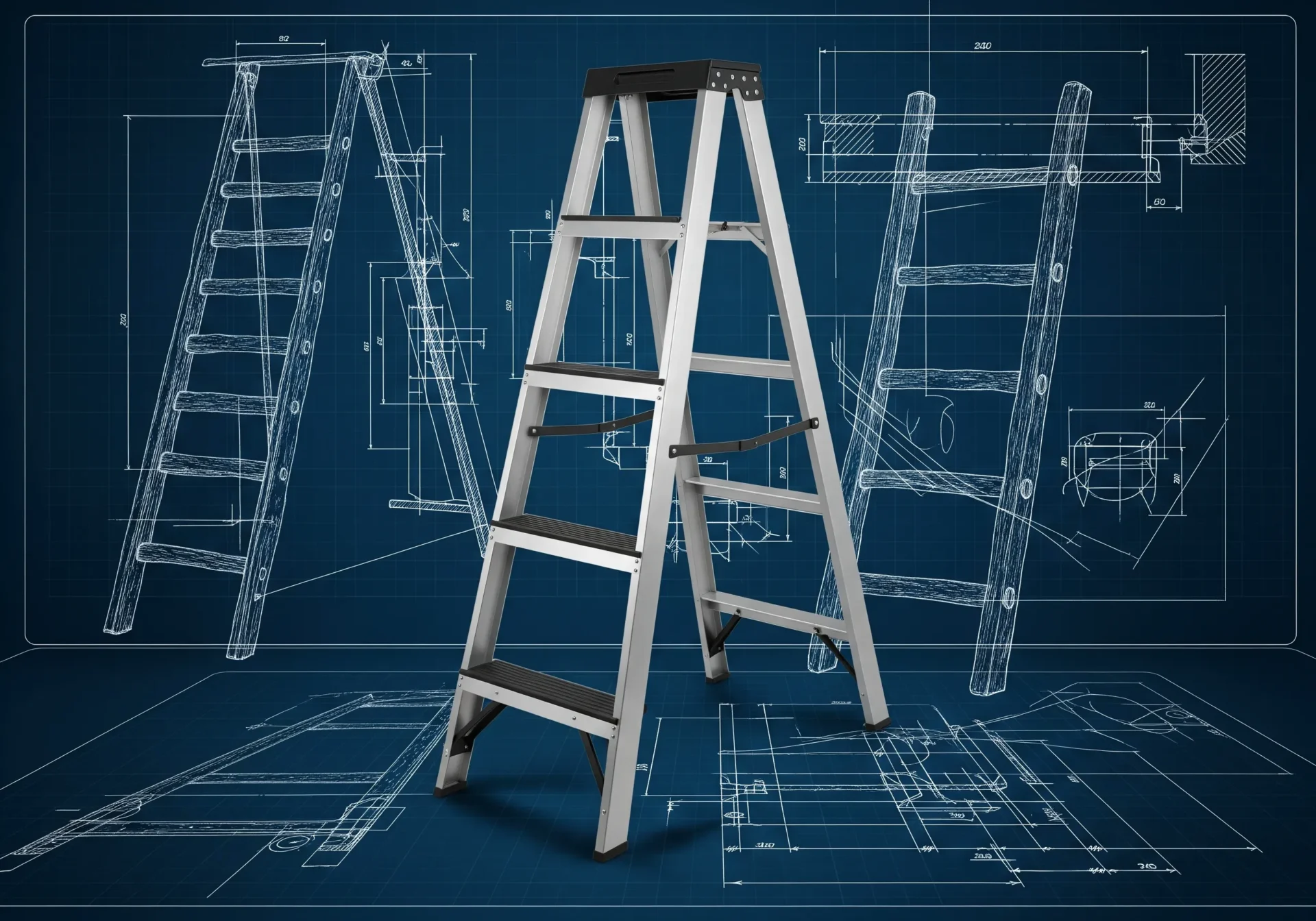Introduction
Ladders and stepladders are among the oldest tools created by humankind to access high places safely and efficiently. From the simple log ladders of the Yayoi period to modern lightweight aluminum and highly insulating FRP (Fiber Reinforced Plastic) products, their materials and structures have evolved significantly. This article provides a comprehensive overview, from their long historical background to domestic and international safety standards and the latest technological trends.
The Origin and History of Ladders and Stepladders
Ancient Ladders
During the Yayoi period, log ladders were excavated from the Toro and Yamaki archaeological sites, where they were used to climb into stilt houses and warehouses. There were also pole ladders made from a single piece of wood, and rope ladders constructed with hemp or palm rope and wooden rungs. Furthermore, during the Warring States period, special military ladders such as the tsugihashi (connecting bridge), nagehashi (throwing bridge), and gyotenkyo (heaven-crossing bridge) were used in castle sieges.
The Birth of the Stepladder
In the Muromachi period, a stand called a kurakake began to be used as a prototype for the stepladder. Originally a stand for a horse’s saddle, it was repurposed for work at heights. The term is believed to have originated from the Chinese words “jiǎotà” (foot tread) or “jiǎotàzi” (footstool). It eventually became widely used in homes and by craftsmen.
Development from the Edo to Meiji Periods
During the Edo period, the demand for gardening and landscaping increased, and the tripod stepladder, which is stable even on uneven ground, became an essential tool for gardeners. Additionally, “stepladder fishing” (kyakutatsu-zuri), where fishermen would set up a stepladder in Edo Bay to sit and fish for Japanese whiting (aogisu), became popular and was depicted in ukiyo-e prints as part of commoner culture. This culture and practicality spurred the diversification of the stepladder’s shape and use.
Evolution of Materials and Design
Changes in Materials
For a long time, wood and bamboo were the primary materials for ladders and stepladders. However, since the 1960s, lightweight and durable aluminum has rapidly become widespread. Subsequently, other materials have emerged, such as rust-resistant and high-strength stainless steel, and FRP (Fiber Reinforced Plastic), which combines insulation with strength. Furthermore, technologies have been developed to enhance corrosion resistance and appearance through anodizing and color anodizing, and to provide surface protection and design appeal through painting treatments.
Structural Innovations
In terms of structure, various improvements have been made, including leg extension mechanisms for stable work on stepped or sloped surfaces, main body extension functions to adjust height, and folding designs for easy storage and transport. To improve safety, the adoption of stabilizers to increase lateral stability and ladder level indicators to check the setup angle at a glance have been effective. Moreover, double and triple pulley systems have been implemented to allow for smooth extension and retraction with less force.
Safety Standards and Certification
Japanese Domestic Standards
In Japan, several standards and laws are in place to ensure the safety of ladders and stepladders. A representative standard is JIS S 1121, which specifies criteria for dimensions, structure, and load capacity of aluminum alloy stepladders and ladders. Additionally, Article 518 of the Ordinance on Industrial Safety and Health mandates the installation of a work platform and fall prevention measures for work at heights of 2 meters or more. Products certified by the Consumer Product Safety Association (CPSA) or the Scaffolding and Construction Equipment Association of Japan have cleared rigorous safety standard tests by a third party and are considered highly reliable.
Overseas Standards
Many safety standards also exist internationally to guarantee the global safety of products. The European standard EN 131 is a general safety standard for ladders, EN 1147 is for firefighting ladders, EN 61478 is for ladders made of insulating material, and EN 14183 is a specific standard for stepladders. In the United States, ANSI A14 provides detailed standards for ladders, while the Australian/New Zealand Standard AS/NZS 1576 specifies safety requirements for work platforms and scaffolding.
The Role of Standards
These standards require products to meet a wide range of conditions, including material properties, dimensions, design load, durability tests, and safety performance criteria. A certification mark is proof that a product complies with the standards, and it should always be checked at the time of purchase. Understanding these standards and certifications leads to selecting safer products and preventing accidents.
Latest Trends and Future Directions
Lighter and More Durable
Recent ladders and stepladders achieve both lightness and strength through hybrid structures combining aluminum and FRP. This has led to an increase in models that are easy to handle even for women, the elderly, or those with less physical strength, thereby improving work efficiency.
Site-Adaptable Functions
Adaptability to the work environment has also improved, with the introduction of extendable legs that can maintain a level position on stepped or sloped surfaces, and insulated types for electrical work. This allows for optimal safety measures tailored to the specific work content and location.
Environment and Sustainability
On the environmental front, the use of highly recyclable materials is expanding, and the number of products with Eco Mark certification is increasing. This makes it possible to choose products that balance sustainable manufacturing and use, reducing the environmental impact.
Digital Safety Assistance
Safety assistance functions utilizing IoT technology are also gaining attention. Systems are being developed that monitor the usage angle and load in real-time and provide alerts in dangerous situations, contributing to accident prevention and enhanced safety.
Conclusion
Over thousands of years of evolution, ladders and stepladders have grown into tools that combine safety, functionality, and environmental performance at a high level. For users, understanding domestic and international standards and certifications and choosing products appropriate for the intended use and work environment is key to preventing accidents and improving work efficiency. In the future, the fusion of material technology innovation and digital technology will advance, leading to the realization of even more sophisticated safety measures and comfortable working environments.

